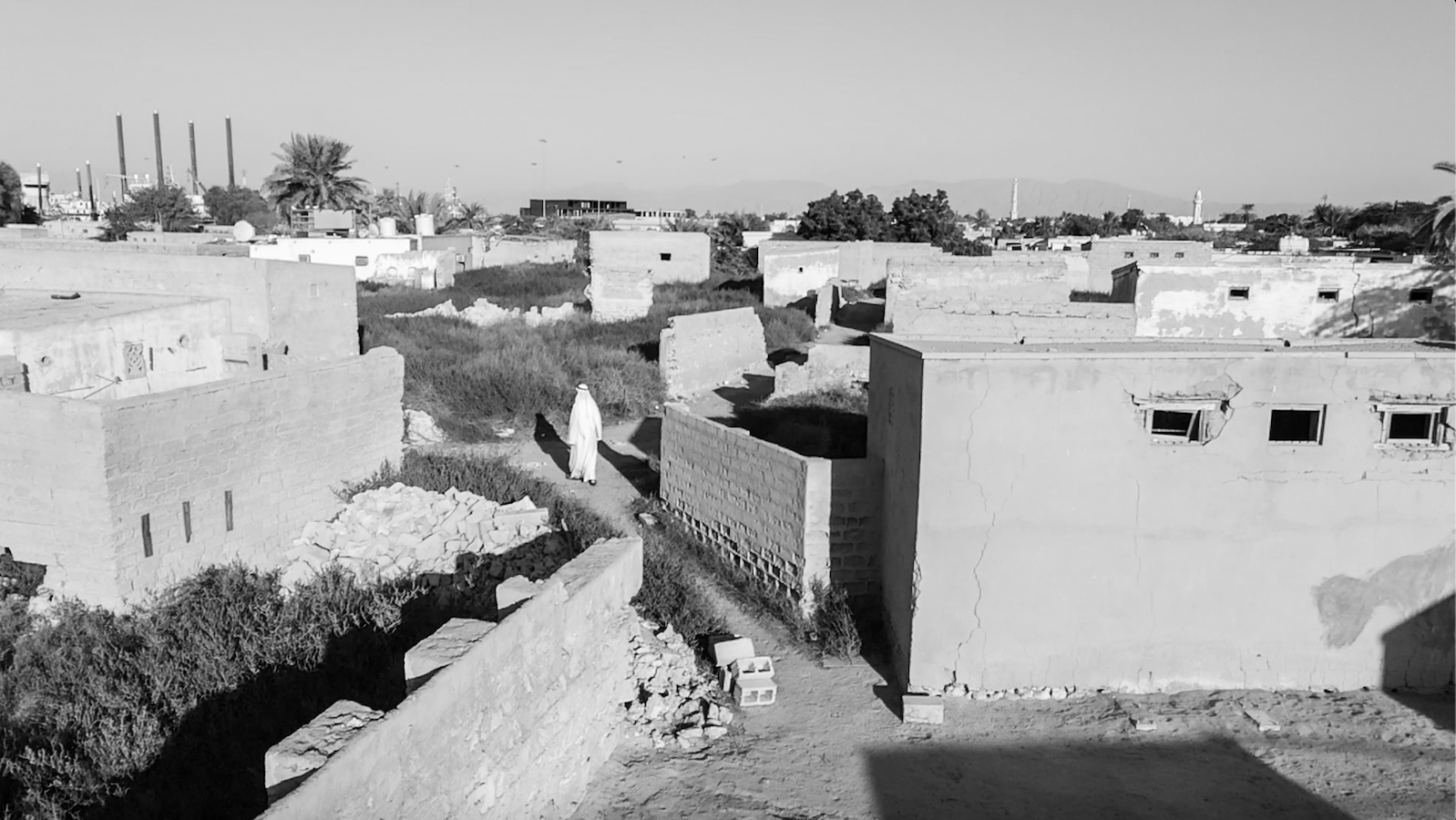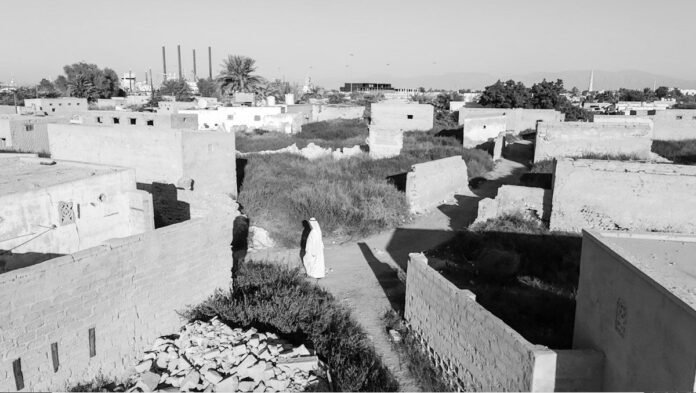DUBAI: Roughly 23 kilometers southwest of Ras Al-Khaimah city lies the abandoned town of Al-Jazirah Al-Hamra. The last surviving pearl diving and seafaring settlement in the country, its ghost-like appearance and traditional coral-stone architecture have proved a magnet for the curious over the years. Now an anthropological spotlight is being shone on the once-vibrant community, providing valuable insight into the lifestyles of those who used to live there.
A series of five short films are being screened in the town until April 3, each providing a glimpse of what life was like prior to its abandonment in the 1960s. Screening as part of the Ras Al-Khaimah Fine Arts Festival, which has been held at Al-Jazirah Al-Hamra since 2019, each film is an oral history, providing an invaluable window into life in the country’s best-preserved coastal community.
“We really wanted to capture the site and showcase all the work that has gone into Al-Jazirah Al-Hamra in recent years, while at the same time using it as a platform to promote modern and contemporary art in the emirate,” says David Dingus, a research associate at the Sheikh Saud bin Saqr Al-Qasimi Foundation for Policy Research, the festival’s organizer. “We received overwhelmingly positive feedback, but everyone wanted to know more about Al-Jazirah Al-Hamra.”

The problem was, very little information was available, so the foundation began researching. It soon became apparent, however, that the only way to gather information would be to interview surviving inhabitants. That in turn would prove challenging, not only because many former residents have died, but because distance and COVID-19 made face-to-face interviews much more difficult.
Initially, respondents tended to be in their fifites, but they were too young to recall the intricacies of life prior to 1968, so the foundation continued searching for older inhabitants. Eventually they tracked down a number of men who were ideal, but not all would or could participate. And although a handful of women were found, none would agree to be filmed. In the end, five men were interviewed for the project.
One of them was Sultan Mohamed Al-Zaabi, who was born in the town and lived there until he was 22. His family had two houses — one in the market and one in the neighborhood of Al-Munakh — and by his late teens he was working as a fisherman, often spending hours at sea.

“Our elders would announce that they would need seven or eight boys to man the ropes on the fishing boat,” Al-Zaabi says in his film. “They would send me out to sea… with 10 or 12 other men and I would man the rope all night long… until dawn. We would come back in the morning and sell the fish for around 20 or 30 or 50 rupees maximum. We would come back tired from being at sea all night. This was the life of working at sea.”
Pearl diving and fishing were the main sources of income, but there were merchants, too, and others who owned livestock or collected firewood from the desert. The town had a large market and shopkeepers would bring rice, flour and sugar from Dubai or Umm Al-Quwain. These merchants were an integral part of the community, providing families with anything they needed until the pearlers or fishermen returned home and paid their dues.
“Living in Al-Jazirah was a blessing,” Hasan Jamal Al-Ahmed remembers fondly. Friends and neighbors would play games including Al-Yarba, Al-Gabba and Al-Zaboot and participate in traditional dances such as Al-Ayyala and Razif. On Thursdays and Fridays, two or three large trays of regag bread would be passed around in the street, he recalls, and during weddings meals would be prepared for the entire neighborhood.

Life was tough, though. Breakfast consisted of dates and coffee, and maybe some bread if you were lucky, and rice and fish would be served for dinner. Medical care consisted largely of traditional remedies and there was no drinking water. The latter had to be brought in by donkey every day before dawn. “One big bottle of water was usually enough for one day or two,” recalls Abdullah Saeed Al-Zaabi. “The water would be poured into the well. As for washing and showering, seawater was used. Every house was near to the sea.”
“Whoever had fish and dates back then lived comfortably,” says Al-Ahmed. “Our house had three stores (rooms), a well, a kitchen, and a majlis. It was not very big, but it was not small either. It was a decent house. Most of Al-Jazirah was built with stones, but a few of the homes were built using palm fronds. Plaster was also a common building material. It would be burned, crushed, and then made. A house would hold up to 10 people. One store was enough for parents and their children to sleep in. There was no electricity, only lanterns.”

Even lanterns were rare. Families would often use masrai — bottles with cotton wicks (the cotton would contain dates and the bottle would contain gas) — for lighting and those who didn’t have electricity would use car batteries to power any electrical devices they might have. There were no telephones either, only a few radios, and when televisions first arrived in the 1960s electricity would be available for only a few hours a day.
In the summer, everybody would leave. For Ibrahim Mousa Al-Zaabi, who was taught to dive with a rock tied around his leg, that meant travelling to Fujairah with his grandfather. “He had a farm with plenty of palm trees,” he recalls. “We would stay for five or six months and then come back, bringing dates on ships. Dates used to be distributed every two days. Every pack of dates had a mark on it. Out of trust between each other, people would go into each house, put the dates down, and leave the house.”

Left untouched for years, the abandoned town has been the subject of restoration work since 2015, when Ras Al-Khaimah’s Department of Antiquities and Museums initiated the Jazirah Al-Hamra Conservation Project. Since then the focus has been on turning the town into a national heritage site, complete with workshops, museum and visitors center.
The challenge now for Dingus is to find a permanent home for the foundation’s oral history project. Whether that will take the form of a permanent fixture at the National Museum of Ras Al-Khaimah or within Al-Jazirah Al-Hamra itself, is uncertain. What Dingus does know, however, is that it’s important to record how its inhabitants used to live.
“We’re losing something with every generation,” he says. “There’s less reinforcement of these stories and their history tends to get lost over time. So we just want to make sure that it isn’t lost and forgotten and that the really unique and rich culture and heritage that was in Al-Jazirah Al-Hamra is remembered.”


